Sky Dye Sampler: Blue
“The history of blue begins with its absence. In any aboriginal language, blue will be the sixth color term to join its primary and secondary kin. I’ve often wondered what took so long for aboriginal poets to add ‘blue’ to their word palettes. My guess is that they already had it in the form of ‘sky-like.’ Just as there was no need for ‘red’ if one had ‘blood-like,’ or ‘green’ if one had ‘leaf-like,’ there was no need for ‘blue’ when one’s roof was a cerulean dome.”—Skip Eisiminger
Skip the B.S.
By Dr. Skip Eisiminger
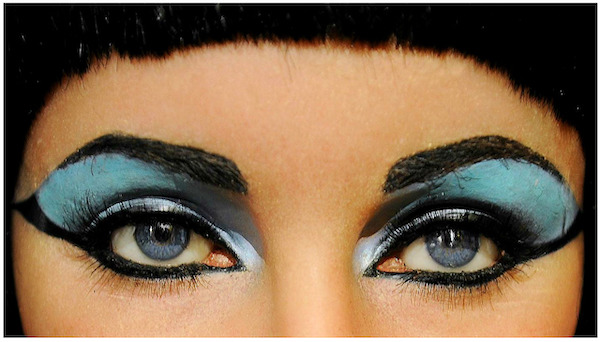
I. “Blue is . . . most suitable as the color of interior life.”―William H. Gass
CLEMSON South Carolina—(Weekly Hubris)—1 March 2022—My audiologist was explaining that the tiny red dot on my new hearing aid meant that it went over my right ear. “Red is right,” she said. “Left is blue.”
“Wouldn’t lavender have made more sense?” Ingrid asked.
“Ha! It might have, but blue is more recognizable and popular.”
Indeed, it is with me and 42 percent of males across the globe. The first time I saw my future wife she was wearing a blue bikini and strolling beside a dancing blue pool. When I mustered the courage to approach her, her beryl-blue eyes closed the deal. Today, Ingrid claims her swimsuit was turquoise, and I argue that turquoise is blue with its decimal moved one place to the right. Her favorite color has changed several times over the last 60 years; mine is steadfastly blue.
I’m not sure where my preference was born, but it might have been the blueberries in my Cheerios,
- or Elvis’s blue suede shoes,
- or the “Presbyterian blue” that graced the churches I grew up in,
- or the “Rhapsody in Blue” I never tire of,
- or the “blue highways” my feet and bike are drawn to,
- or the bouquet of forget-me-nots Dad used to give Mother on their anniversary,
but I suspect my preference stems from the Delft vases and table clock that Mother purchased on the black market after World War Two. These three items were the first things I or anyone else saw entering or leaving our home, wherever the Army happened to station us.
For the stone in my high-school graduation ring, I chose a blue spinel. A few months after I’d seen Ingrid at poolside, I gave it to her, but when it swallowed her hand, she gave it to her younger brother, who lost it swimming in the North Sea. Neither understood the significance of that ring because Germans don’t have the school-ring tradition popular in the US, but if it can’t be on my finger, I want that ultramarine stone rolling beneath the sea.
Ingrid and I have lived quietly on Blue Ridge Drive since 1980. On a good day, one can see the Appalachian’s “Blue Wall” from our bedroom window, and on a very good day, one can see forever.
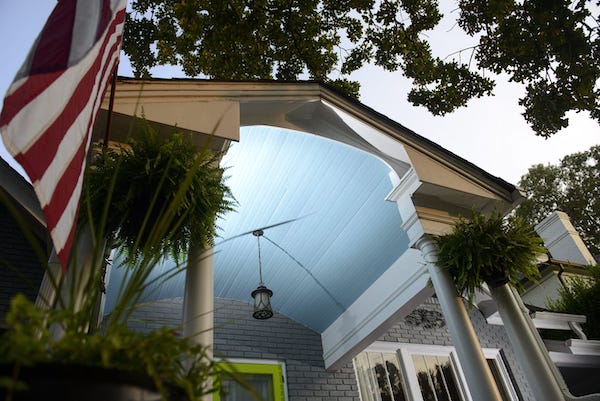
II. “In 1840, two boats left port. One from Charleston was loaded with dye from the indigo plantations. The other from Colombia departed with a load of cochineal. Unfortunately, they collided, spilling their cargoes and leaving the crews marooned.”—Lew Fitch
Once a rigorous blue-stater, Billy Bluet has learned to make a meal of bleu cheese on white crackers and red wine which has turned him “purple.” As such, neither Billy nor Bess, his blue-jeaned wife of 50 years, has any use for the Bluebook Social Register, blue noses, blue bloods, or blue stockings of any age. Neither has a blueprint for success except hard work and daily doses of Selsun Blue for their itchy scalps. Both love the blues and bluegrass because nothing cures a blue funk quicker than music tinted “blue.” When needed, the bluebird of happiness offsets the heft of a blue Monday with a blue-plate special. These meals are prepared by Bess, a cordon-bleu chef, who inherited some blue-chip stock from Bluebeard, her eccentric grandfather and former pirate. Trained in sky-blue math, Bess is, nevertheless, more comfortable watching a blue movie or cussing a blue streak at a blue-collar ballet. Privately, Billy likes to brag that he hasn’t had the blue balls since he married a former member of the “Blue Man Review.” Though Billy retired his blue pencil when he left Big Blue, once in a blue moon, he edits a manuscript for his grandson, whose first novel dealt with underpaid nurses participating in a blue flu, who were attacked by some blue-eyed devils and their bluetick hounds.
Our blue-ribbon pair once thought they’d sell their “haint-blue” home and chase the blue flower, fly off into the wild blue yonder, or retire as blue-water sailors, but that plan turned into a blue fizzle when a winter storm capsized their K-Mart “blue-light special” leaving them permanently blue around the gills. After the pair invested in a Humboldt cyanometer, they discovered they were content to measure the sky’s fifty-two shades from their own backyard without a single mention of “blue.”
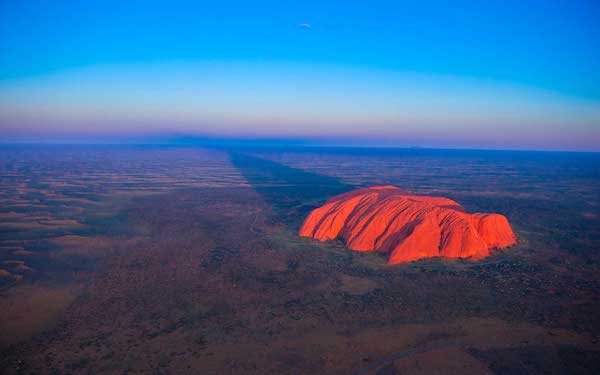
III. “Arthur Rimbaud thought the long ‘o’ was as blue as a bruised toe.”—James Dickey
The history of blue begins with its absence. In any aboriginal language, blue will be the sixth color term to join its primary and secondary kin. I’ve often wondered what took so long for aboriginal poets to add “blue” to their word palettes. My guess is that they already had it in the form of “sky-like.” Just as there was no need for “red” if one had “blood-like,” or “green” if one had “leaf-like,” there was no need for “blue” when one’s roof was a cerulean dome.
At Lascaux and Altamira, one looks in vain for blue because the animals these cave dwellers hunted were mostly brown, white, or black. Blue, if they could have produced such a dye, might have compromised the sympathetic magic they depended on to put meat in their fire. There was no blue for the same reason there were no people on the walls; primary colors and humans just complicated an already complex and uncertain process.
When the Egyptians finally figured out how to brew a blue dye, it required a small army of slaves to feed a fire and operate a bellows for 24 hours to brew a batch for the pharaoh’s new robe. On the Mediterranean coast, Tyrian slaves had to eviscerate some 10,000 murex snails to make a single gram of a purple dye. No wonder purple was associated with royalty—the king alone could afford it.
Having marveled at the blue in several European cathedral windows, I’m tempted to say that the splendor of that color never exceeded “Chartres blue,” which is an integral part of the glass, not a stain applied after it had cooled. For my money, that blue is the deepest and purest ever made by humans, though in the twentieth century, Marc Chagall, working at the New York Met, came very close to matching the glass that has fragmented the sun in northern France for almost 800 years.
In the 17th century, Isaac Newton stuck a needle behind his eye to understand the physics of color, and he came away with blue roughly in the center of the color spectrum followed by two close relatives: indigo and violet. In a stroke of genius, Newton divided an infinitely divisible spectrum into sevenths because the well-established musical scale offered an irresistible parallel.
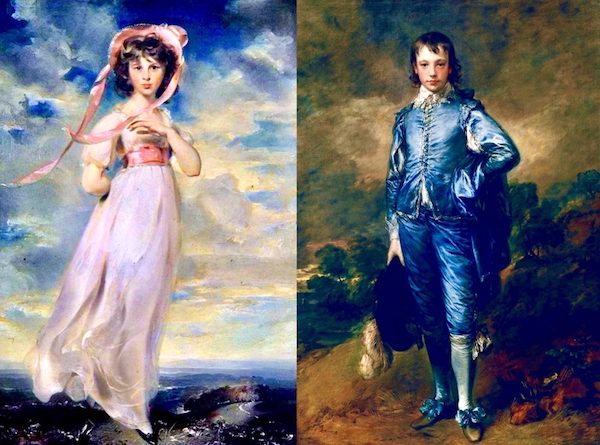
Affordable synthetic dyes introduced at the end of the 19th century finally allowed for the democratization of color. Before 1860, one could spot European aristocrats by the colors they came to town in; black, gray, and brown identified almost everyone else. Though Giotto had spent about a third of the 14th century searching for “the hue of heaven,” suddenly blues were everywhere.
In 1859, mauve, a close relative of blue, was introduced by 18-year-old William Henry Perkin, the chemist who brewed it and named it for the mallow, a purple wildflower it resembled. By the 1890s, mauve was so popular, the decade took its name from it. The white clothes of 19th-century children could now be fringed in blue for girls to give them the protection boys had long enjoyed. (Think of Thomas Gainsborough’s “The Blue Boy,” 1770, and Thomas Lawrence’s “Pinkie,” 1794, pretty in her white gown and pink sash.)
In the 1910s, Alice Roosevelt, the artist-daughter of Teddy, lent her name to “Alice blue,” and in the 1920s, Italian fashion designer Elsa Schiaparelli gave the world “ice blue.” In 1958, at the height of the Cold War, Crayola changed “Prussian blue” to “midnight blue” because no one remembered Prussia and the word was too close to “Russia.” Not only was it a gorgeous shade of blue, it happens to be an antidote for heavy-metal poisoning.
In 1968, thanks to the Apollo lunar missions, humans had their first chance to see their “blue marble” home set against the black void of space, which gifted the world with “instant global consciousness,” now considered by many the spark that lit the environmental movement.
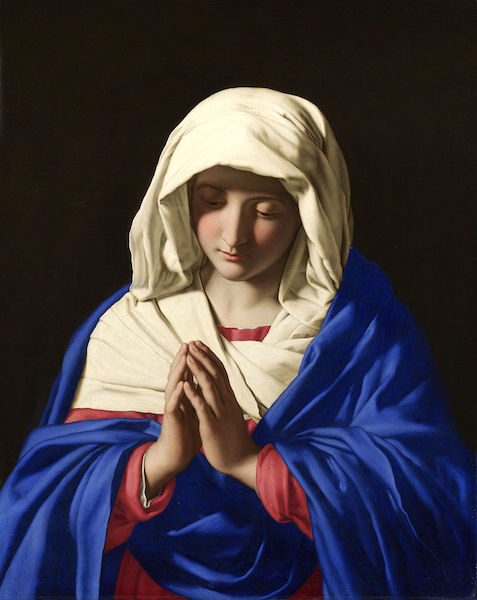
IV. [Blue is] “everlastingly appointed by the Deity to be a source of delight.”—John Ruskin
“I have always been scared of you [and] . . . your Aryan eye, bright blue.”—Sylvia Plath
Blue is a colorful paradox:
- While only 35 percent of Germans are blue-eyed blonds, Hitler had steel-blue eyes and brown hair.
- As Billy and Bess Bluet learned, nothing cures the blues like the blues.
- The color-blind uncle of a friend ordered a brown car because brown looked blue to him, and blue was his favorite color. Sadly, he saw his blue eyes in the mirror as brown.
- Blue coloring makes a more effective sleeping pill, but Viagra, the “little blue pill,” arouses the slumbering beast.
- Few would prefer to drink coffee from an all-blue mug when white is available, but blue is fine for tea.
- Blue is America’s favorite color, but only 7 percent of our cars are blue.
- In 1927, “Time” noted that many American department stores were urging parents to dress young girls in blue and boys in pink. In the 1940s, the same stores reversed this message for some vaguely commercial reasons.
- Bluing a fabric turns it white.
- Blue is soon bleached by the sun, yet the ruby laser stands a zero chance of removing a blue tattoo.
- If “color is the suffering of light,” as Melissa Green has argued, blue masks its “pain” better than the rest.
- Color keeps humans from despair, but blue is tinged with melancholy.
- G. Heinz-Mohr thought blue had “the transparence of the void to come,” but Christian painters have traditionally painted Mary’s heavenly robe blue.
- In Australia and New Zealand, a “bluey” refers to someone with red hair.
- Blue is Red China’s favorite color.
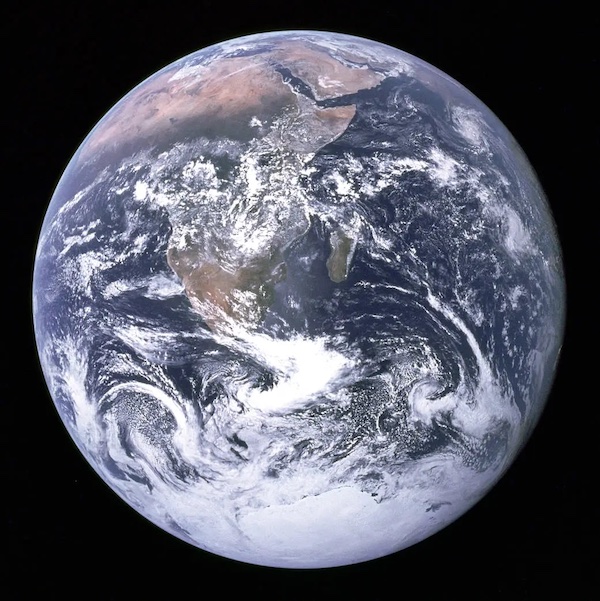
V. “What did I do to be so black and blue?” —Andy Razaf
Robert Frost complained that the blues he often found in nature were “fragmentary . . . when heaven presents in sheets the solid hue.” A more common complaint is that nature has not given us enough blue plants, animals, and precious stones. But consider the following animals: the blue damsel fish, the blue poison dart frog, and Dory, the royal blue tang.
As for flowers, consider the blue iris, the blue orchid, and the Texas bluebell. Finally, consider these precious and semi-precious stones: lapis lazuli, sapphires, and the Hope diamond. To be sure, you won’t find these in every backyard garden, pond, or gravel drive, but they are lovely and solid blue to boot.
My neighbor’s bumper sticker proclaims, “Blue lives matter.” Of course, they do, but so do black, brown, and white. The French artist Yves Klein was so nuts about blue that he mixed a cocktail of his “Klein blue” that turned his urine the same patented color. Dr. Josef Mengele tried his best to turn brown-eyed Jewish children blue but succeeded only in blinding or killing them. The Russian artist Wassily Kandinsky thought that blue alone had “the power of profound meaning.” The revered indigo dyers of India are said to have “Krishna hands.” And male robins take better care of the chick that emerges from the bluest shell.
Regrettably, stories like these have given many the impression that blue is better. It isn’t. Blue-eyed hunters may have had a small advantage in the northern latitudes 50,000 years ago, but for everyone living south of Siberia and the Yukon, brown was better. There’s nothing magical about blue. While it’s true that humans owe the air we breathe and the sky above us to the waste products of blue-green algae, all colors matter, but blue moves me like no other.

To order copies of Skip Eisiminger’s Letters to the Grandchildren (Clemson University Digital Press), click on the book cover below or contact: Center for Electronic and Digital Publishing, Strode Tower, Box 340522, Clemson SC 29634-0522. For Wordspinner: Mind-Boggling Games for Word Lovers, click on the book cover.




2 Comments
Skip Eisiminger
I still think those are your eyes, not Liz’s.
Elizabeth Boleman-Herring
I wish, Skip: I could have really monetized THOSE peepers!